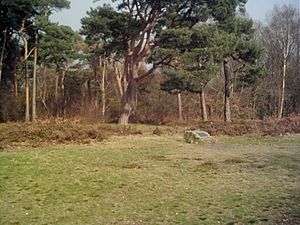Croham Hurst facts for kids
| Site of Special Scientific Interest | |
 |
|
| Area of Search | Greater London |
|---|---|
| Interest | Biological |
| Area | 33.6 hectares |
| Notification | 1984 |
| Location map | Magic Map |
Croham Hurst is a special natural area in South Croydon, London. It is a large hill, about 33.6 hectares (that's like 83 football fields!). This area is known as a Site of Special Scientific Interest (SSSI) because it is very important for nature. It is also a "Site of Metropolitan Importance for Nature Conservation," which means it is a key natural spot in London.
Croham Hurst is an ancient woodland, but you won't find many super old trees there. This is because, a long time ago, people used the wood for fuel before railways made coal cheap. The hill has different types of trees depending on where you are. On the lower parts, you'll see lots of oak and hazel trees growing in rich soil. Higher up, beech trees are common. Near the very top, you'll find oak and birch trees.
The top of the hill is mostly bare, with rounded pebbles. These pebbles formed about 50 million years ago when this area was covered by shallow seas. The plants at the top are mainly wavy hair-grass, heather, and bilberry.
Contents
A Hill of Many Layers
This hill is also a Regionally Important Geological Site. This means its rocks and how it formed are special. The lower parts of the hill are made of something called Thanet Sands. These sands have worn away over time. But the very top of the hill is made of Blackheath pebble beds. These pebbles are held together by a natural cement. This strong layer has stopped the top of the hill from wearing away, creating a natural cap.
Croham Hurst Through Time
People have lived in the Croham Hurst area for thousands of years!
Stone Age Settlements
- In 1968, scientists found signs of two old hut sites. These were part of a Mesolithic settlement, which means people lived there about 5,000 to 3,000 years BC.
- Later, during the Neolithic period (the New Stone Age), people continued to live here. We know this because flint tools from that time have been found.
- There is also a Bronze Age round barrow on the hill. A barrow is a large mound of earth built over a burial site. This one is a Scheduled Ancient Monument, which means it's protected by law because it's so important. You can even find a plaque marking the spot!
Medieval Times and Public Ownership
- During the medieval period, Croham was one of four important areas in the parish of Sanderstead.
- In the late 1500s, Sir Olliphe Leigh, who owned Croham, sold it to John Whitgift. He was the Archbishop of Canterbury at the time.
- Croham Hurst then became part of the Whitgift Foundation. This is a charity that helps with education and nursing, and it's still running today!
- In the late 1800s, Croham Hurst became a popular place for visitors. However, most people didn't know it was private land.
- In 1898, the Whitgift Foundation announced plans to sell parts of the land for building. The people of Croydon quickly started a campaign to save the hill.
- Thanks to their efforts, the entire area was bought by the Croydon Corporation on February 8, 1901. This made it public land for everyone to enjoy.
- In 1965, Croham Hurst became part of the London Borough of Croydon.
Recent Events
- Sadly, in June 2018, the site was badly damaged by a fire.
How to Visit Croham Hurst
You can get to Croham Hurst from several roads:
- Croham Manor Road
- Bankside
- Upper Selsdon Road


